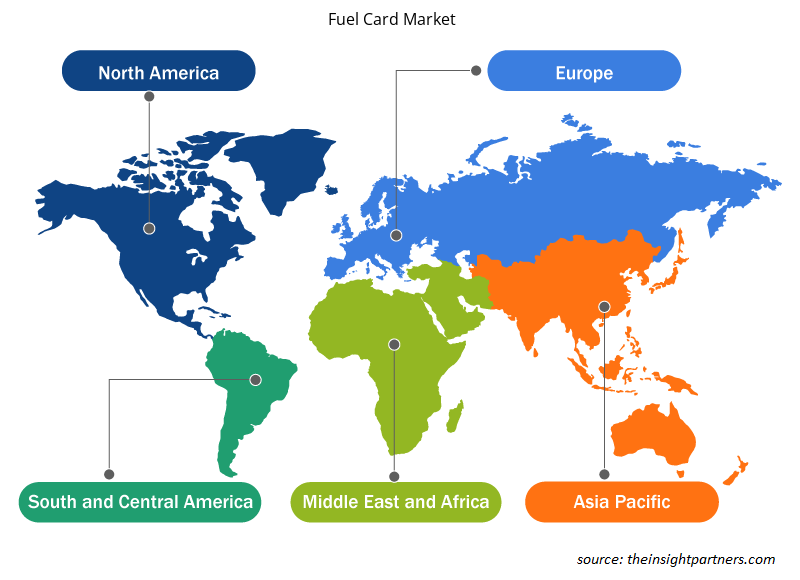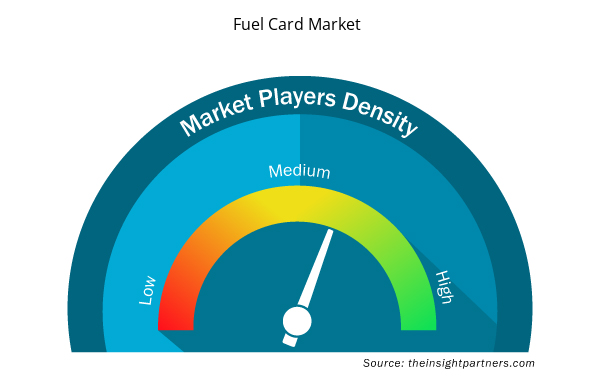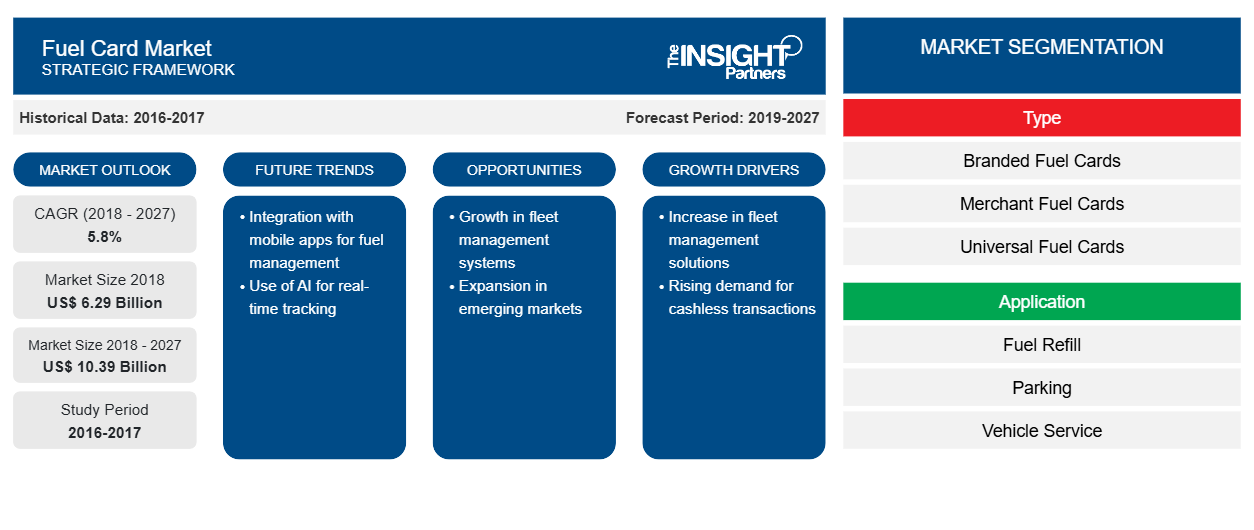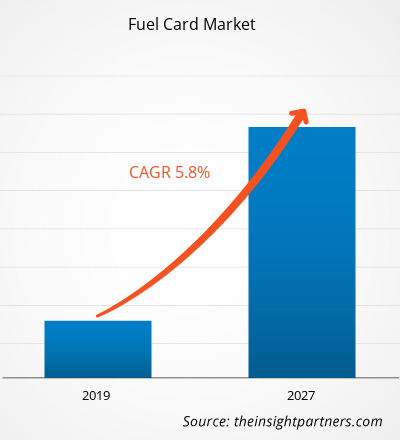[研究报告] 2018 年全球燃油卡市场规模估计为 62.9 亿美元,预计在 2019 年至 2027 年预测期内的复合年增长率为5.8%,到 2027 年将达到 103.9亿美元。
北美地区在燃油卡收入方面占有相当大的市场份额,预计在整个预测期内,北美地区将继续占据主导地位。通用卡是最方便的燃油卡类型,这些卡的提供商通常与多家加油公司合作,并提供极大的灵活性。某些燃油卡公司仅在某些国家或地区运营,而其他公司可能仅在特定加油站接受。所在地区选择较少的用户可能需要谨慎,不要将他们限制在少数加油站。
燃油卡市场洞察
通过增强数据采集实现高效的车队管理
燃油卡通过跟踪车队中车辆的实时里程和燃油使用情况,可以增强对车队费用和车队效率的跟踪。车队运营商使用燃油卡支付卡车维护、卡车维修、燃油、卡车清洁和更换车辆租赁等费用。燃油卡捕获的数据包括里程表读数、燃油等级、燃油产品和燃油数量、车辆 ID、驾驶员 ID 和税务信息,以及交易细节(例如时间、地点、消费金额和日期)为车队经理提供丰富的支持。这一因素将在预测期内推动燃油卡市场的需求。
定制此报告以满足您的需求
您可以免费定制任何报告,包括本报告的部分内容、国家级分析、Excel 数据包,以及为初创企业和大学提供优惠和折扣
- 获取此报告的关键市场趋势。这个免费样品将包括数据分析,从市场趋势到估计和预测。
使用燃油卡的欺诈风险较低
与小额现金等其他燃油支付方式相比,使用燃油卡在功能性和安全性方面具有优势。卡上可以印有车辆登记号码或驾驶员姓名以及公司名称,从而进一步防止欺诈性使用或加油卡。有关所有燃油交易的综合信息可减少员工滥用的可能性,并提供对真实车辆使用的卓越控制。因此,全球燃油卡市场预计将增长。
类型细分洞察
燃油卡市场按组成部分可分为品牌燃油卡、商户燃油卡和通用燃油卡。燃油卡通常由中小企业和大型企业使用,以跟踪其燃油消耗并方便进行无现金支付。此类卡最常用于从事运输和车队管理的企业或组织。在该领域运营的不同公司提供不同类型的卡。这些卡除了加油外,还用于其他多种用途。按发行方划分,燃油卡大致可分为独立卡或品牌卡。
应用程序细分洞察
根据应用,全球燃油卡市场已细分为加油、停车、车辆服务、通行费等。燃油卡使用户和企业主能够管理和控制燃油和维护费用。它们通常用作加油站的燃油支付卡。此外,这些卡还可用于支付其他车辆服务,如维修、保养以及路边援助。由于报告范围广泛,多张燃油卡使用户能够获得实时报告,从而帮助他们及时了解所有业务费用以及管理车辆税。
燃油卡市场区域洞察
Insight Partners 的分析师已详尽解释了预测期内影响燃油卡市场的区域趋势和因素。本节还讨论了北美、欧洲、亚太地区、中东和非洲以及南美和中美洲的燃油卡市场细分和地理位置。

- 获取燃油卡市场的区域特定数据
加油卡市场报告范围
| 报告属性 | 细节 |
|---|---|
| 2018 年市场规模 | 62.9 亿美元 |
| 2027 年市场规模 | 103.9亿美元 |
| 全球复合年增长率(2018 - 2027) | 5.8% |
| 史料 | 2016-2017 |
| 预测期 | 2019-2027 |
| 涵盖的领域 | 按类型
|
| 覆盖地区和国家 | 北美
|
| 市场领导者和主要公司简介 |
|
加油卡市场参与者密度:了解其对业务动态的影响
燃油卡市场正在快速增长,这得益于终端用户需求的不断增长,而这些需求又源于消费者偏好的不断变化、技术进步以及对产品优势的认识不断提高等因素。随着需求的增加,企业正在扩大其产品范围,进行创新以满足消费者的需求,并利用新兴趋势,从而进一步推动市场增长。
市场参与者密度是指在特定市场或行业内运营的企业或公司的分布情况。它表明在给定市场空间中,相对于其规模或总市场价值,有多少竞争对手(市场参与者)存在。
在燃油卡市场运营的主要公司有:
- 英国石油公司
- 埃克森美孚公司
- Fleetcor 技术公司
- 荷兰皇家壳牌公司
- 美国银行
免责声明:上面列出的公司没有按照任何特定顺序排列。

- 获取燃油卡市场顶级关键参与者概览
据观察,一些市场举措是全球燃油卡市场最常采用的策略。以下列出了一些近期的市场举措:
2019 年:Edenred Capital Partners 在与 Edenred 业务相关的领域投资具有高增长潜力的创新企业。其目标是通过与所支持的公司建立有价值的协同效应来增强集团的生态系统。2018
年:Edenred 是全球领先的企业、员工和商户交易解决方案提供商,今天宣布签署协议,收购英国第四大燃油卡项目管理公司 The Right Fuelcard Company (TRFC) 集团 80% 的股权。
全球加油卡市场细分
全球燃油卡市场 – 按类型
- 品牌加油卡
- 商户品牌加油卡
- 通用加油卡
全球燃油卡市场 – 按应用分类
- 燃料补充
- 停車處
- 车辆服务
- 通行费
- 其他的
全球燃油卡市场 – 按地区划分
北美
- 我们
- 加拿大
- 墨西哥
欧洲
- 法国
- 德国
- 意大利
- 英国
- 西班牙
- 欧洲其他地区
亚太地区 (APAC)
- 中国
- 印度
- 日本
- 澳大利亚
- 亚太地区其他地区
中东和非洲 (MEA)
- 沙特阿拉伯
- 阿联酋
- 南非
- 中东和非洲其他地区
南美洲
- 巴西
- 南美洲其他地区
全球燃油卡市场 - 公司简介
- 英国石油公司
- 埃克森美孚公司
- Fleetcor 技术公司
- 荷兰皇家壳牌公司
- 美国银行
- Wex 公司
- 丹麦国防军
- 世界燃料服务
- 埃德纳德
- Radius 支付解决方案。
Allstar、Arco、Caltex、Chevron Texaco、Commdel、EDC、Engen Petroleum Ltd.、FastFuel、Fleetcare Pty Ltd、fuelGenie 和 Fuelman 是价值链中其他一些市场参与者,报告中没有列出,但可以根据要求纳入。
- 历史分析(2 年)、基准年、预测(7 年)及复合年增长率
- PEST 和 SWOT 分析
- 市场规模价值/数量 - 全球、区域、国家
- 行业和竞争格局
- Excel 数据集


- Precast Concrete Market
- Artificial Intelligence in Healthcare Diagnosis Market
- Vision Guided Robotics Software Market
- Nitrogenous Fertilizer Market
- Embolization Devices Market
- Rugged Phones Market
- Identity Verification Market
- Artificial Intelligence in Defense Market
- Photo Editing Software Market
- Sodium Bicarbonate Market

Report Coverage
Revenue forecast, Company Analysis, Industry landscape, Growth factors, and Trends

Segment Covered
This text is related
to segments covered.

Regional Scope
North America, Europe, Asia Pacific, Middle East & Africa, South & Central America

Country Scope
This text is related
to country scope.
Trends and growth analysis reports related to Banking, Financial Services, and Insurance : READ MORE..
The List of Companies
- BP P.L.C.
- Exxon Mobil Corporation
- Fleetcor Technologies, Inc.
- Royal Dutch Shell plc
- U.S. Bank
- Wex Inc.
- DKV
- World Fuel Services
- Edenerd
- Radius Payment Solutions
The Insight Partners performs research in 4 major stages: Data Collection & Secondary Research, Primary Research, Data Analysis and Data Triangulation & Final Review.
- Data Collection and Secondary Research:
As a market research and consulting firm operating from a decade, we have published and advised several client across the globe. First step for any study will start with an assessment of currently available data and insights from existing reports. Further, historical and current market information is collected from Investor Presentations, Annual Reports, SEC Filings, etc., and other information related to company’s performance and market positioning are gathered from Paid Databases (Factiva, Hoovers, and Reuters) and various other publications available in public domain.
Several associations trade associates, technical forums, institutes, societies and organization are accessed to gain technical as well as market related insights through their publications such as research papers, blogs and press releases related to the studies are referred to get cues about the market. Further, white papers, journals, magazines, and other news articles published in last 3 years are scrutinized and analyzed to understand the current market trends.
- Primary Research:
The primarily interview analysis comprise of data obtained from industry participants interview and answers to survey questions gathered by in-house primary team.
For primary research, interviews are conducted with industry experts/CEOs/Marketing Managers/VPs/Subject Matter Experts from both demand and supply side to get a 360-degree view of the market. The primary team conducts several interviews based on the complexity of the markets to understand the various market trends and dynamics which makes research more credible and precise.
A typical research interview fulfils the following functions:
- Provides first-hand information on the market size, market trends, growth trends, competitive landscape, and outlook
- Validates and strengthens in-house secondary research findings
- Develops the analysis team’s expertise and market understanding
Primary research involves email interactions and telephone interviews for each market, category, segment, and sub-segment across geographies. The participants who typically take part in such a process include, but are not limited to:
- Industry participants: VPs, business development managers, market intelligence managers and national sales managers
- Outside experts: Valuation experts, research analysts and key opinion leaders specializing in the electronics and semiconductor industry.
Below is the breakup of our primary respondents by company, designation, and region:

Once we receive the confirmation from primary research sources or primary respondents, we finalize the base year market estimation and forecast the data as per the macroeconomic and microeconomic factors assessed during data collection.
- Data Analysis:
Once data is validated through both secondary as well as primary respondents, we finalize the market estimations by hypothesis formulation and factor analysis at regional and country level.
- Macro-Economic Factor Analysis:
We analyse macroeconomic indicators such the gross domestic product (GDP), increase in the demand for goods and services across industries, technological advancement, regional economic growth, governmental policies, the influence of COVID-19, PEST analysis, and other aspects. This analysis aids in setting benchmarks for various nations/regions and approximating market splits. Additionally, the general trend of the aforementioned components aid in determining the market's development possibilities.
- Country Level Data:
Various factors that are especially aligned to the country are taken into account to determine the market size for a certain area and country, including the presence of vendors, such as headquarters and offices, the country's GDP, demand patterns, and industry growth. To comprehend the market dynamics for the nation, a number of growth variables, inhibitors, application areas, and current market trends are researched. The aforementioned elements aid in determining the country's overall market's growth potential.
- Company Profile:
The “Table of Contents” is formulated by listing and analyzing more than 25 - 30 companies operating in the market ecosystem across geographies. However, we profile only 10 companies as a standard practice in our syndicate reports. These 10 companies comprise leading, emerging, and regional players. Nonetheless, our analysis is not restricted to the 10 listed companies, we also analyze other companies present in the market to develop a holistic view and understand the prevailing trends. The “Company Profiles” section in the report covers key facts, business description, products & services, financial information, SWOT analysis, and key developments. The financial information presented is extracted from the annual reports and official documents of the publicly listed companies. Upon collecting the information for the sections of respective companies, we verify them via various primary sources and then compile the data in respective company profiles. The company level information helps us in deriving the base number as well as in forecasting the market size.
- Developing Base Number:
Aggregation of sales statistics (2020-2022) and macro-economic factor, and other secondary and primary research insights are utilized to arrive at base number and related market shares for 2022. The data gaps are identified in this step and relevant market data is analyzed, collected from paid primary interviews or databases. On finalizing the base year market size, forecasts are developed on the basis of macro-economic, industry and market growth factors and company level analysis.
- Data Triangulation and Final Review:
The market findings and base year market size calculations are validated from supply as well as demand side. Demand side validations are based on macro-economic factor analysis and benchmarks for respective regions and countries. In case of supply side validations, revenues of major companies are estimated (in case not available) based on industry benchmark, approximate number of employees, product portfolio, and primary interviews revenues are gathered. Further revenue from target product/service segment is assessed to avoid overshooting of market statistics. In case of heavy deviations between supply and demand side values, all thes steps are repeated to achieve synchronization.
We follow an iterative model, wherein we share our research findings with Subject Matter Experts (SME’s) and Key Opinion Leaders (KOLs) until consensus view of the market is not formulated – this model negates any drastic deviation in the opinions of experts. Only validated and universally acceptable research findings are quoted in our reports.
We have important check points that we use to validate our research findings – which we call – data triangulation, where we validate the information, we generate from secondary sources with primary interviews and then we re-validate with our internal data bases and Subject matter experts. This comprehensive model enables us to deliver high quality, reliable data in shortest possible time.


 获取此报告的免费样本
获取此报告的免费样本